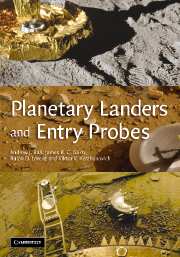Book contents
- Frontmatter
- Contents
- Preface
- Acknowledgements
- List of acronyms and abbreviations
- PART I Engineering issues specific to entry probes, landers or penetrators
- 1 Mission goals and system engineering
- 2 Accommodation, launch, cruise and arrival from orbit or interplanetary trajectory
- 3 Entering atmospheres
- 4 Descent through an atmosphere
- 5 Descent to an airless body
- 6 Planetary balloons, aircraft, submarines and cryobots
- 7 Arrival at a surface
- 8 Thermal control of landers and entry probes
- 9 Power systems
- 10 Communication and tracking of entry probes
- 11 Radiation environment
- 12 Surface activities: arms, drills, moles and mobility
- 13 Structures
- 14 Contamination of spacecraft and planets
- PART II Previous atmosphere/surface vehicles and their payloads
- PART III Case studies
- Appendix Some key parameters for bodies in the Solar System
- Bibliography
- References
- Index
7 - Arrival at a surface
Published online by Cambridge University Press: 12 August 2009
- Frontmatter
- Contents
- Preface
- Acknowledgements
- List of acronyms and abbreviations
- PART I Engineering issues specific to entry probes, landers or penetrators
- 1 Mission goals and system engineering
- 2 Accommodation, launch, cruise and arrival from orbit or interplanetary trajectory
- 3 Entering atmospheres
- 4 Descent through an atmosphere
- 5 Descent to an airless body
- 6 Planetary balloons, aircraft, submarines and cryobots
- 7 Arrival at a surface
- 8 Thermal control of landers and entry probes
- 9 Power systems
- 10 Communication and tracking of entry probes
- 11 Radiation environment
- 12 Surface activities: arms, drills, moles and mobility
- 13 Structures
- 14 Contamination of spacecraft and planets
- PART II Previous atmosphere/surface vehicles and their payloads
- PART III Case studies
- Appendix Some key parameters for bodies in the Solar System
- Bibliography
- References
- Index
Summary
This chapter covers the final moments of descent towards, and contact with, a solid (or, as in the case of Titan, possibly liquid) surface. We deal with the issues of surviving impact to deliver a working spacecraft to the surface. This usually requires some sort of prior deceleration achieved during descent. Active guidance, navigation and control can also be performed to avoid hazards and locate a safe landing site. Having arrived, the impact may be damped within the vehicle alone, or by also using the deformability of the surface.
Targeting and hazard avoidance
Thus far, planetary landers have been flown ‘open loop’ in terms of their horizontal targeting with respect to the surface. While feedback control is employed to regulate descent rate to achieve close-to-zero speed at zero altitude, only the horizontal speed tends to be controllable, not the location.
The Mars Exploration Rovers incorporated a camera system (DIMES – Descent Image Motion Estimation System) to sense sideways motion, and a set of rocket motors (TIRS – Transverse Impulse Rocket Subsystem) to null the motion to maximize the probability of successful airbag landing; Surveyor and other lunar landers similarly used multibeam Doppler radar and thrusters to null horizontal motion. However, the latitude and longitude co-ordinates of the landing site were simply those that happened to be under the spacecraft when its height became zero. These were within an expected delivery ellipse specified by entry conditions and uncertainties, etc., but were not controlled.
- Type
- Chapter
- Information
- Planetary Landers and Entry Probes , pp. 71 - 83Publisher: Cambridge University PressPrint publication year: 2007

